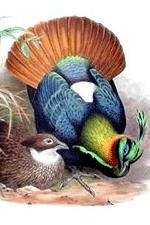

These birds average about 2 ½ feet in length, males weigh 4.4 - 5.2 pounds, with hens weighing slightly less. Male juveniles resemble hens until the age of two when they become fully feathered.
#Himalayan monal pheasants for sale skin#
Both males and females have a patch of turquoise-blue, bare skin around the eyes.įemales, like many other types of pheasants, are much duller in coloration, being mostly a mottled brown, with a white throat, and smaller, brown crest. Males are also adorned with beautiful feathering, that is almost metallic-looking and includes blue, green, red, copper, and white. They are not recommended for warmer climates.ĭescription: Males have a tall, beautiful crest, reminiscent of the peacock. Impeyans are very tolerant of the cold weather and will need plenty of shade during the summer to protect them from extreme heat. Impeyans are a high-altitude species, between 2,100 and 4,500 meters above sea level. They prefer grassy meadows in the summer and forested areas in the winter. Range: Northern India, Western China, Afghanistan, Nepal - the Himalayas Subspecies: There may be one subspecies in Northern India that lacks the visible white patch on the rump while the bird is in flight, but continues to be debated among experts. Add Impeyan Pheasants to your flock and your friends will be jealous for sure. Impeyan Pheasants are extremely beautiful birds. They are also called Himalayan Monal Pheasants.

Males were hunted heavily for their crests until the 1980s when they became protected.Impeyan Pheasants for sale September until sold out for the year usually in December. Impeyans live in large coveys in the winter and play a large role in the folklore of their native home. Plants in aviaries don't stand a chance with this species. They eat invertebrates, roots, and tubers quite happily. Impeyans have strong beaks and love to dig. Lady Impey was the first westerner to keep Impeyan Pheasants in captivity. Miscellaneous Notes: Impeyans are named after Lady Mary Impey, who was the wife of the British Chief Justice of Bengal, Elijah Impey. Status in aviculture: Impeyans are well established in aviculture and are bred and raised in aviaries and zoos throughout the world. Their natural habitat is being overdeveloped in many areas, and it is not known if any are left in Afghanistan at all. Status in the wild: The International Union for the Conservation of Nature (ICUN) lists Impeyans as threatened.


Impeyan Pheasants for sale September until sold out for the year usually in December.


 0 kommentar(er)
0 kommentar(er)
